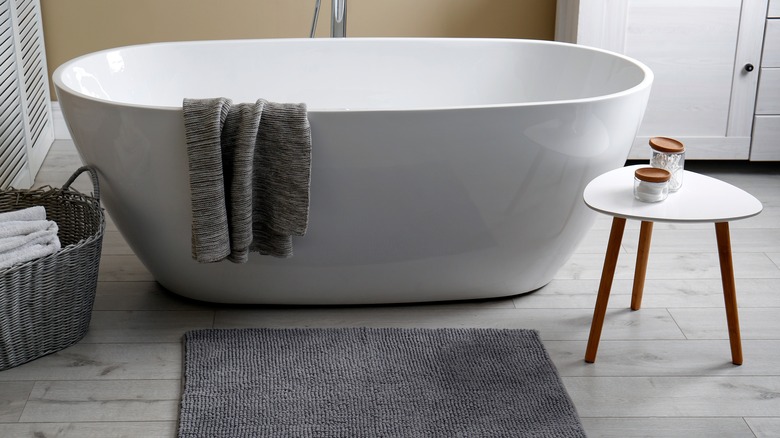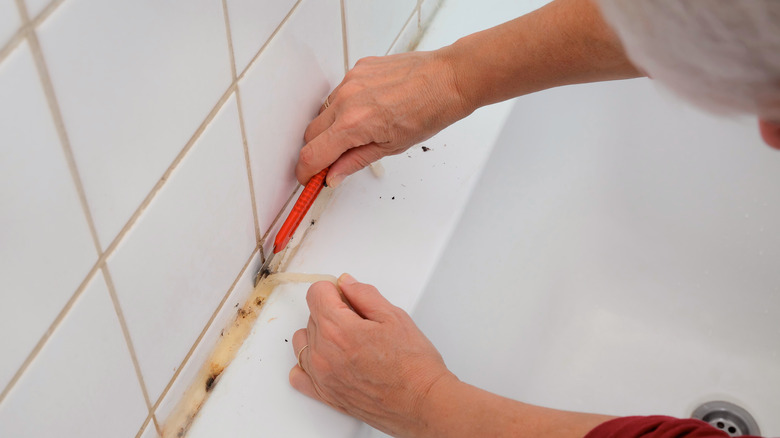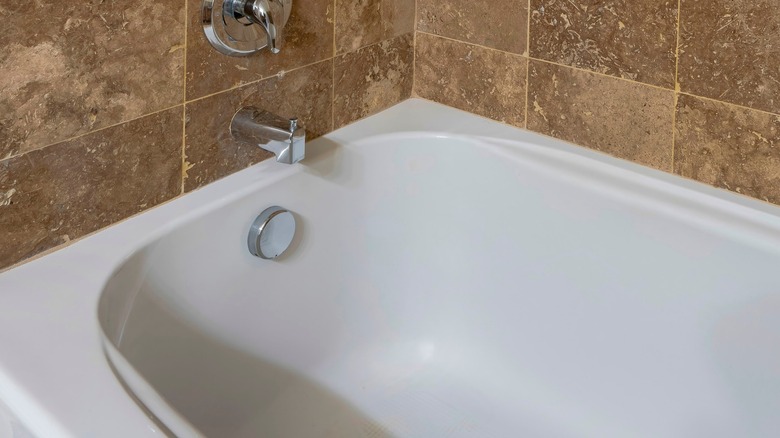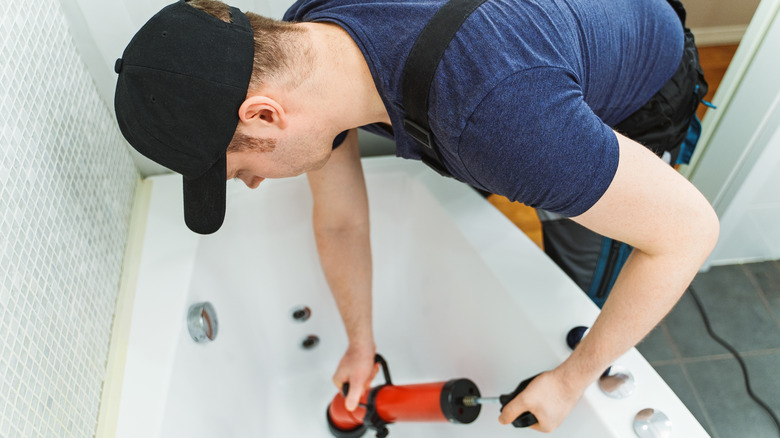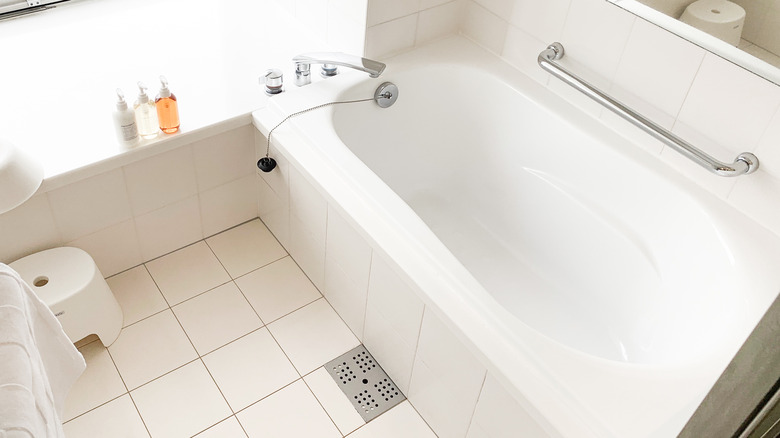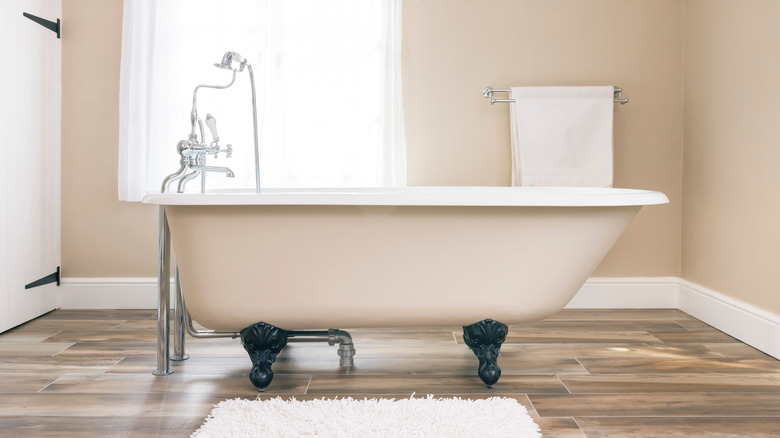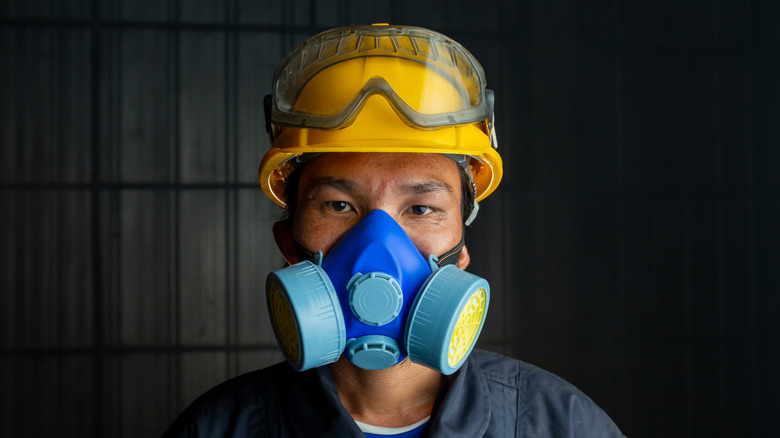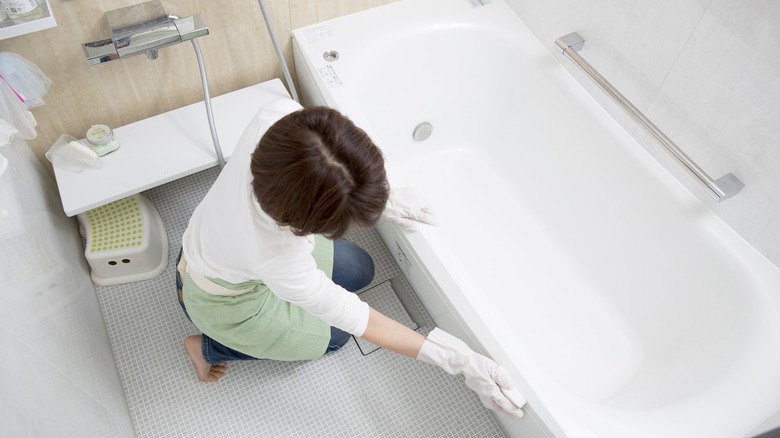What You Need To Know Before Refinishing Your Bathtub
Over time, bathtubs can begin to look dated or worn out. As 1A Florida Plumbing, Inc. explains, cleaners, hard water, soap scum, and mildew can all cause discoloration. This can leave the bathtub looking dirty, even when it has just been cleaned. Refinishing a damaged bathtub can help you give your older tub a facelift. America Refinish Pros shares that refinishing can restore a bathtub's finish, getting rid of discoloration, chips, and cracks.
Another reason to refinish a bathtub is to update the color. If you own an older home, and the bathtub has never been replaced, its color may be making your bathroom feel old and outdated. As Old House Online explains, blue, green, pink, and other colors were once popular for bathtubs and other bathroom fixtures, like sinks and toilets. While these colors may have been popular in the mid-1900s, they do not match current design trends. Therefore, you may also be looking to refinish your bathtub to bring your bathroom into the 21st century.
What is bathtub refinishing?
According to Today, the term bathtub refinishing refers to the process of resurfacing a bathtub. The process — which may also be called reglazing, resurfacing, refinishing, or recoating — starts with sanding down the current finish of the tub. Sealers are then applied to address any cracks, chips, or rough areas. After this step is complete, multiple layers of primer, paint, and glaze are applied over the entire surface. The process is completed by giving the tub a buffing to make it sleek and shiny.
Refinishing is a relatively inexpensive project and can save homeowners a lot of money compared with completely replacing a tub. However, as it is more of a cosmetic fix, it may not address underlying problems with the tub. This could make it necessary to refinish the tub again in the future. Not all bathtubs will be a candidate for refinishing; those with more serious damage will require replacement.
How is refinishing different from reglazing?
As mentioned above, the terms refinishing and reglazing are often used to refer to the same process. However, while these terms are often used interchangeably, they each have a unique meaning. Jacksonville Bathman Refinishing explains that reglazing is technically just one step in the refinishing process. When a bathtub is reglazed, the new coating is added over the sanded and repaired bathtub. Reglazing is the final phase of the refinishing process.
Bathtub refinishing refers to all of the various components in the process. First, the tub needs to be sanded down to remove the current glaze and finish. Then, any chips or cracks are filled in to ensure that the bathtub is in good condition. Finally, as described above, the reglazing process works to give the tub a new finish.
The term bathtub repair may also be used alongside, or in place of, either refinishing or reglazing. However, it too technically has its own separate definition. Bathtub repair applies to the first few steps in the process where the tub is sanded down to remove rust and any cracks and chips are filled in.
Can you refinish a bathtub yourself?
Homeowners can purchase reglazing kits to complete a DIY bathtub refinishing. Lowe's outlines the necessary steps for this project, which start with removing the spouts, plugs, and other hardware from the tub. After all of the hardware has been removed, you'll also need to remove any caulk surrounding the tub. Next, use bleach or an abrasive bathroom cleaner to give the tub a deep cleaning. Once cleaned, be sure to thoroughly rinse the tub and dry it.
Now, you're ready to start the refinishing process. Tape off walls, tile, and other areas around the tub. Then, you'll want to use the etching powder included in the reglazing kit to take off the tub's existing glaze. Work carefully and use some elbow grease when scrubbing to make sure the entire finish is removed, otherwise, the new glaze may not adhere properly. Use a wet/dry sandpaper (400-grit) to create a rough surface on the entire tub. This step is important because the new coating will adhere much better to a rougher surface than it will to a smoother one.
If your reglazing kit came with a primer, apply it next. If no primer was included, then it likely means that the kit includes a self-priming epoxy coating. After priming, follow the kit's directions to mix the epoxy resin and hardener together. Apply even coats to the tub using a roller or a sponge brush along the edge. Read the directions to confirm the number of necessary coats and how long each coat should dry before moving on to the next coat. After letting the tub cure according to the package's instructions, re-caulk the tub and put the hardware back. Give the tub a final cleaning before using it.
While you can refinish a tub yourself, as you can see, it is a rather involved process. White Glove Bathtub and Tile Reglazing explains that hiring a professional may be a better option. Professionals are experienced and have received training to ensure that the process is completed correctly. They will also use professional-grade materials, which can deliver longer-lasting results than you can get with a DIY kit. Professionals will also know how to safely deal with the chemicals used during the process, allowing you to minimize your exposure to anything potentially dangerous.
How quickly will a refinished tub be ready for use?
Refinishing a bathtub is a relatively quick process, especially compared to renovating the entire bathroom and replacing the tub. According to Miracle Method, the process of removing the existing finish, sanding down the tub, filling in cracks, and applying the new finish generally takes between 3 and 5 hours. However, the bathtub won't be ready for immediate use. The new finish and glaze will need to fully cure before the tub can be used.
While Glove Reglazing notes that the curing process takes between 24 and 48 hours. The exact drying time can vary based on a number of factors, including humidity, ventilation, and temperature. Bathtubs in warm, humid, or poorly-ventilated bathrooms will take longer to dry (possibly three or four days) than those in cooler, drier, and properly ventilated bathrooms. The reglazing company you hire should be able to give you an estimate for when your tub will be ready for use. There are also some faster-drying glazing materials that may be available. However, these options will also be more expensive, so you'll need to take that into account when you're deciding what to use.
How long does the finish last?
There is no cut-and-dry answer to this question. Maryland Tub & Tile shares that bathtub refinishing typically lasts between 10 and 15 years. However, your finish could last longer (or shorter) than this depending on a variety of factors.
For example, the finish on a bathtub that is used more frequently is less likely to last as long as one that is rarely used. Between the more frequent showers/baths and the additional cleanings that come along with more regular use, the finish will be worn down more quickly. Use is not the only factor that will help determine how long bathtub refinishing will last. Care also plays a huge role. When the tub is cleaned regularly, it prevents gunk and dirt from getting caked onto the finish. Removing caked-on debris is much more difficult, and will require more abrasive cleaners, which can decrease the lifespan of the glaze.
If the finish was not allowed to cure fully after the refinishing process, then it is also less likely to last as long. Similarly, if the tub was not properly sanded down and prepared, it is more likely that the new finish did not adhere as well to the tub, resulting in less durability.
How much does bathtub refinishing cost?
Forbes shares that the average cost of refinishing a bathtub is about $480. This average includes the cost of hiring a professional company to complete the refinishing process. However, $480 is just the average cost, which means that some individuals will pay less and some will pay more to have their bathtub refinished. The lowest cost cited by Forbes for refinishing was $200, with the highest cost being $1,000.
In addition to your location which can impact the cost of goods and services, the type of bathtub that you want to get refinished will also influence your total cost. Refinishing a fiberglass bathtub can be more labor-intensive than refinishing some other tub types. Refinishing may cost up to $1,000, with some simpler projects costing closer to $300.
Antique porcelain clawfoot tubs are also more expensive to refinish, generally costing between $500 and $1,200. The cost to refinish other types of porcelain tubs is a bit less expensive, averaging $475. Refinishing cast iron bathtubs tends to run between $350 and $600.
Can you refinish a tub more than once?
If you have already refinished your bathtub years ago and want to refinish it again, it may or may not be possible. As Maryland Tub & Tile explains, refinishing a bathtub a second time is often possible. Some bathtubs are too damaged or in such poor shape that refinishing them another time won't be feasible. A professional bathtub refinishing company can assess the condition of your bathtub and offer advice as to whether it can be refinished again. This also stresses the importance of choosing a reputable and knowledgeable company to work with for your first refinishing job. Reputable and experienced professionals will complete the process correctly using the ideal tools and materials. This will make it much less likely for your tub to become damaged, and therefore less likely to need a second refinishing.
If you are able to refinish your bathtub a second time, keep in mind that it will likely require additional prep work to be ready for the refinishing process. Because of this, the company you hire may charge a little extra for the additional time that they will need to spend working on your project. Even if your bathtub can be refinished a second time, it is unlikely that you'll be able to refinish it a third time. In most cases, the refinishing process can only be used for a maximum of two times. After this, it will be time to consider bathtub replacement.
Is reglazing safe?
According to the Centers for Disease Control and Prevention, some of the agents used during the bathtub refinishing process are dangerous. One of these chemicals, methylene chloride, has been identified as the cause of death for at least 14 individuals who were stripping the finish from a bathtub during the refinishing process. If it is not used properly, methylene chloride can pose serious health concerns and the CDC says that this chemical should not be used when possible. The poor ventilation conditions in many bathrooms only add to the dangers that methylene chloride poses.
If you're planning to refinish your bathtub yourself, Topkote shares the importance of properly ventilating the area. It is also essential to wear a face mask to protect yourself from inhaling the fumes and to protect yourself by wearing gloves, safety goggles, and chemical-resistant clothing. Other steps to take include following local guidelines for dealing with spills or leaks and using long-handled tools to keep your face farther away from the tub and the fumes.
Groveland Bathtub Refinishing recommends hiring professionals if you're planning to refinish your bathtub. Professionals have experience working safely with methylene chloride. They have the required safety and ventilation equipment to use the chemical without posing a serious risk to their health or the health of others in the home.
Are there any special considerations when cleaning a refinished bathtub?
Following proper care and bathroom cleaning recommendations can help protect the glaze and extend the lifespan of your refinished bathtub. Fox Valley Bathtub Refinishing highlights several dos and don'ts that individuals should keep in mind when cleaning their refinished tubs. First, it is important to choose the right cleaning products. Use a soft sponge when cleaning a refinished tub and avoid using any abrasive cleaners. Some acceptable cleaners include dish soap, water and vinegar, and commercially-available bathroom cleaners that are non-abrasive.
In addition to avoiding abrasive cleaners, there are other cleaning methods that can damage the surface of a refinished bathtub. One popular cleaning method that you shouldn't use with reglazed bathtubs is steam cleaning. A steamer can damage the finish. Similarly, a power washer should never be used to clean a refinished bathtub as the stronger water pressure may also damage the glaze. While not specifically related to cleaning, suction cups can also damage the coating on a refinished bathtub. For this reason, you should avoid using bath mats with suction cups on your refinished tub.
When is it better to install a new bathtub?
Refinishing can be a cost-effective alternative to purchasing a new bathtub. However, according to Bathroom Pros New Jersey, there are times when refinishing doesn't make sense and it is best to just have a new bathtub installed. For one, if your existing tub is severely damaged with rust, dents, or cracks, refinishing won't be a viable option. If you're not sure whether the damage to your tub is extensive enough that refinishing won't be possible, reach out to a local professional for a consultation.
Another time when it is often best to just purchase a new tub is if your existing bathtub is outdated and won't help you achieve the design goals for your bathroom. Whether the bathtub's style doesn't match your vision or you really need a different type of bathtub (stand-alone vs connected to the wall) to remodel your bathroom, it may be the right decision to purchase a new model instead of trying to work with what you have.
